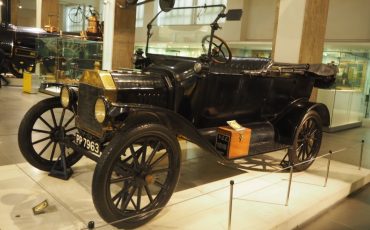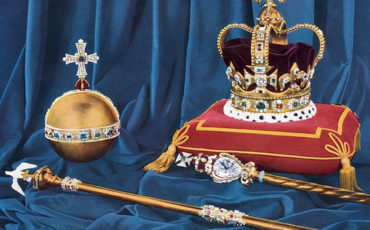Most people have heard of the native American princess known as Pocahontas, but not many know that she became a Christian, married an Englishman, and came to London as a young bride and mother. Sadly, she never made it home to America and is buried in the town of Gravesend in Kent, having died in 1617 at the start of her journey homewards.
Pocahontas was born around 1596 and named Amonute; although she was originally known as Motaka, the name Pocahontas came later. Her father, Powhatan, was a chief, while her mother – who may have died in childbirth – is unknown. She was born into a native American tribe that lived near the early British settlement called Jamestown. This was named in honour of King James the First, who had succeeded Elizabeth the First on her death in 1603, thus uniting the royal houses of England and Scotland. James was the son of Mary Stuart (often called Mary, Queen of Scots). He never knew either of his parents, his father was murdered before he was born, and his mother was imprisoned and later executed in England while he was brought up in Scotland. James had a Tudor grandmother and a Stuart mother, so he came to the throne of England when Elizabeth died, thus bringing about the unification of England and Scotland under one crown – which remains the case today.

A 19th-century depiction of Pocahontas. Photo Credit: © Unknown Author via Wikimedia Commons.
In the early 1600s, many religious dissenters, who did not accept the teachings of the established church, began emigrating to America. This new country was part of Britain, and settlers established places such as Jamestown. Later they rebelled against British rule, fighting for and winning independence in 1776. This encroachment into a land occupied by native Americans for centuries was not always welcome and led to frequent conflict between immigrants and local tribes. Thousands of schoolchildren play cowboys and Indians simply because of Columbus’s mistaken belief that he would reach India if he sailed across the Atlantic Ocean. Nowadays, the correct term used to refer to the indigenous people of America is ‘native American.’
Pocahontas, as she is known, was born into one of these tribes and grew up in the area called Virginia. This colony, now a state, was named after Elizabeth, the Virgin Queen, who never married. Virginia is still famous for its tobacco, which Sir Walter Raleigh is reputed to have brought to Britain in the late 1500s and was thought by many – including Raleigh – to be a health-giving substance. It was traditional for native tribes and settlers to smoke tobacco in a “pipe of peace” as a signal that hostilities had ended.
Pocahontas’ father was chief of the tribe she was born into, and according to tradition, she became the apple of his eye as she grew up. Native American men were allowed to take several wives. The name Pocahontas means “little wanton,” and this may give a clue to her character as a young girl.
As Pocahontas was growing up, Jamestown was being established, and conflict with local indigenous tribes became inevitable as resources were fought over. The leader of the colony was called John Smith, a colourful character who had gone off to sea at the age of sixteen, served as a mercenary, become enslaved, fought and killed three Turks in single combat, and drawn up a map of the area around Jamestown after he was appointed its leader. In 1608 he was captured by Powhatan’s tribe and faced execution.
It was at this time that Pocahontas came to his rescue. The story of how she pleaded with her father to spare his life, and he did so, was told by Smith himself. His account is not considered entirely reliable, and he may have embellished it. However, all these events took place over four hundred years ago and it is impossible now to separate fact from fiction.
What is certain is that Pocahontas became the most famous native American woman. She would only have been about twelve when the salvation of Smith reputedly took place, so she was not yet fully grown to womanhood, and the relationship between her and Smith would have been entirely chaste. She entered the white community of Jamestown, became a Christian, and was baptised with the name Rebecca, thus helping to bring about peace between the immigrant outsiders and the local native American tribes.
Pocahontas did marry one of the settlers from Jamestown, a tobacco farmer named John Rolfe. He had been married before, but his first wife and child had died, so Pocahontas became his second wife. He brought her to England with him, the journey across the Atlantic being both long and dangerous, taking at least six weeks on a sailing ship.
When the couple arrived in England in 1616, Pocahontas was admitted to the royal court and met King James. He was a fairly unprepossessing character who delighted in the company of handsome young men whom he established as court favourites. He and his wife Anne of Denmark had produced several children, including the young man who was expected to be his successor. Sadly, Henry the Ninth, as he would have been, never came to the throne but died of typhoid in 1612 after swimming in the heavily polluted River Thames.

The Grade II-listed statue of Pocahontas in Gravesend, Kent. Photo Credit: © Ethan Doyle White via Wikimedia Commons.
James was heartbroken at the loss of his eldest son, who had become friendly with the then-imprisoned Raleigh in the Tower of London. Henry’s younger brother Charles became the next king, but England became plunged into civil war, and a short-lived republic was established under Oliver Cromwell, which collapsed soon after Cromwell’s death in 1658.
Pocahontas herself died at the age of twenty-one. Rolfe, being a mere tobacco farmer, had not been permitted into the court of King James, who was a well-known and early opponent of the consumption of tobacco. Rolfe decided to return to America with his wife, who had by this time borne a son called Thomas. Sadly she never made the journey back across the Atlantic as she contracted a disease, possibly smallpox, and died soon after the ship set sail from London in 1617. Pocahontas was buried at Saint George’s church in Gravesend.
Rolfe, feeling that his motherless son would not survive the arduous journey across the Atlantic, left Thomas in the care of relatives and sailed alone back to his tobacco farm. He never saw Thomas again but knew that his son had been brought up safely in England. Later, Thomas married and had children of his own. The actor Edward Norton and Edith Wilson, wife of the early twentieth-century American President Woodrow Wilson, are amongst those who claim to be descended from Thomas and thus from Pocahontas herself.
The exact location of Pocahontas’ grave is unknown, as Saint George’s church was damaged by fire after her death. However, those who wish to pay homage to her can do so at a statue standing in the churchyard, which shows her in native American clothes. During her time in London, she was dressed in the costume of a seventeenth-century Englishwoman with a bonnet and frilly collar, which she probably found uncomfortable and restricting.
Another statue of Pocahontas used to stand in Red Lion Square in the Holborn area of central London. This showed her reclining and naked and was made by the sculptor David McFall. He had been commissioned by the publishers Cassells who used to have their office in a building now occupied by the Royal College of Anaesthetists. The statue was removed in 1981 and sold at auction for £7500 in 1995; its whereabouts are currently unknown.
Many people will be familiar with the name Pocahontas and will have heard her story told in a 1995 Walt Disney cartoon film in which John Smith was voiced by the Australian actor Mel Gibson and Pocahontas by Irene Bedard, an actress who specialises in native American roles. The Disney version of her story, however, is not entirely accurate as it imagines a romance between Smith and Pocahontas, which could never have taken place as she was only twelve years old at the time these events are alleged to have happened.
John Smith is also remembered in London. A statue of him stands next to the church of Saint Mary le Bow in Cheapside, where the famous Bow bells ring out. In order to be a true Londoner, you should be born “within the sound of Bow bells,” which not many are today as this is largely a business area with a small population. However, it is close to the cathedral of London, Saint Paul’s, and many Blue Badge Tourist Guides conducting tours of the City of London will stop to remember the colourful Smith, who first told us the story of Pocahontas.

Statue Of Captain John Smith next to St Mary-le-Bow Church in Cheapside area of London. Photo Credit: © Lonpicman via Wikimedia Commons.







Leave a Reply